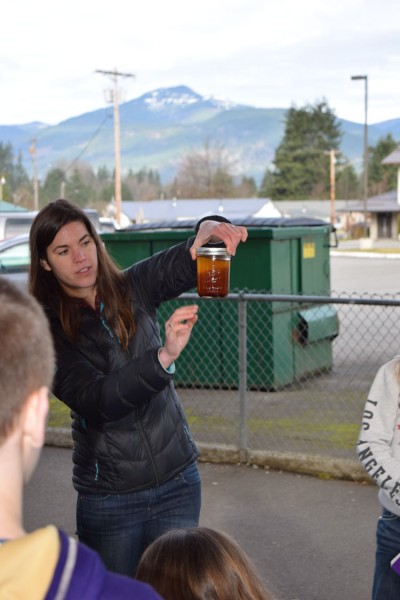Middle School Students Examine Renewables
By Betsy Fradd, WSU Extension
It’s all about the possibilities. For a group of middle school students in the small logging town of Darrington, Washington turning fry grease into biodiesel opened their minds to a much larger picture of energy consumption, jobs, and the future of their community.
Advanced Hardwood Biofuels Northwest (AHB) team members, part of Washington State University Extension, showed the 100 students how to make renewable biodiesel and discussed how different types of fuel impact climate change.
“Students learned they can make alternative fuel themselves from resources in the community,” said Marina Heppenstall, AHB WSU Extension Coordinator. “In this case, used fry grease, that would normally be thrown away, was donated from a local restaurant.”

Heppenstall and her colleagues demonstrated the step by step method to make biodiesel. Students helped by taking turns shaking the jar of biodiesel to complete one of the final steps in the chemical process. Being able to see the chemicals react and to test the biodiesel by burning it brought home the science message and, possibly, sparked an interest for future scientists, environmentalists, and other occupations.
Oak Rankin, WSU Snohomish County Extension Coordinator, works with Darrington students to make science relevant to them. “By participating with AHB’s activity they gained first hand visual experience of the process that brings the energy to their lives,” said Rankin. “Converting garbage fry grease to biodiesel brought the creation of a fuel, from the abstract, to a chemical reaction they can recreate independently. This leads to an understanding that we play a role and are a part of the energy cycle and play a part in the overall balance of chemicals and health of the planet.”

A hands-on activity with black balloons, which represented carbon, showed students how CO2 from burning fossil fuels ends up in the atmosphere trapping heat and contributing to climate change. They also used the balloons to discover how carbon in renewable biofuels creates a sustainable system as plants continue to grow and re-grow and absorb CO2.
“Before, the students had never considered creating their own fuel and the idea seemed remote,” said Rankin. “Now, they can begin thinking of possibilities. Whether it be for them to see a tree, as a living fuel source to power jet planes, as part of an ecosystem, or as part of the energy, water, and carbon cycles. And then for the student to say ‘what else?’ and answer it.”
